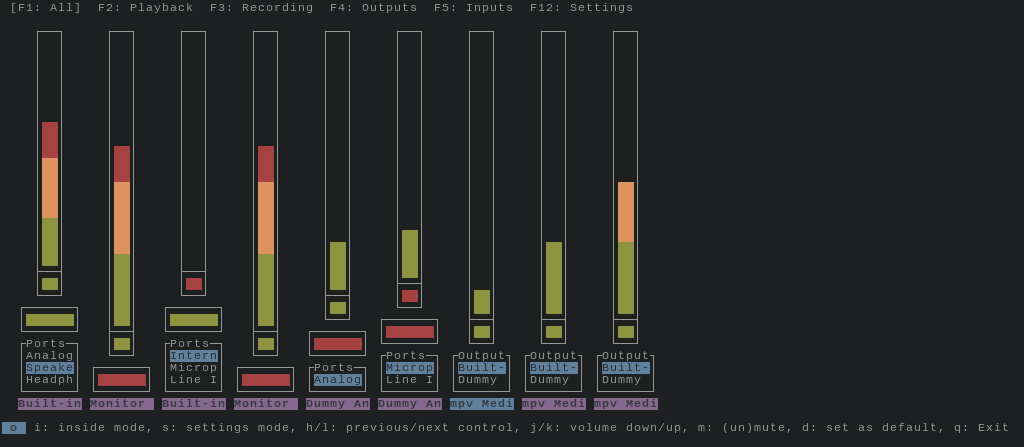pacmixer is an alsamixer alike for PulseAudio.
I started this, because I've found no full-blown, terminal based mixers available for PA. All there are are either CLI or some kinds of GNOME/KDE applets. That's not what I wanted, so in the end I decided to go for it myself.
It was also a good starting point to finally learn myself some ObjC :).
Back in the old days, there were a good mixer for ALSA (alsamixer), so I thought about taking some of their ideas, mix it with mine, and see what happens.
Updating past 0.5: Configuration mechanism has been reworked to be more flexible and integrate better with GNU/Linux environment. It means that:
- Pacmixer configuration is no longer available through settings tab (it is reserved for PA options).
- Settings are now configured using configuration file.
- Settings configured with version <= 0.5 will be reset to defaults after update.
- Settings storage follows XDG => No more creepy "GNUStep" directory.
- libpulse
- ncurses
- gnustep-base
- gcc-objc (for compilation)
- ninja (for compilation)
# ./mk installNote: There is also an introductory video available here, thanks to @gotbletu.
Note: man pacmixer is your friend now as well.
pacmixer comes with built-in help, but here's the shortcuts reference, just in case.
h (or Left): Moves to the previous control.
l (or Right): Moves to the next control.
k (or Up): Increases the volume standardly.
K (or Shift+Up): Increases the volume fastly.
j (or Down): Decreases the volume standardly.
J (or Shift+Down): Decreases the volume fastly.
m: Mutes the volume.
d: Sets as default.
i: Enters inside mode.
s: Enters settings mode.
q (or Esc): Exits settings/inside mode or exit the application.
F1-F5 (or 1-5): Switches to All/Playback/Recording/Outputs/Inputs view, respectively.
F12 (or 0): Switches to Settings view.
Used to change card wise settings (e.g. profiles).
h (or Left): Moves to the previous group of settings.
l (or Right): Moves to the next group of settings.
k (or Up): Moves to the previous setting within group.
j (or Down): Moves to the next setting within group.
space: (Un)checks highlighted setting.
q (or Esc): Exits the application.
Used to adjust specific channel's volume.
All shortcuts (besides q) work the same, except that they affect single channel instead of the whole sink/source.
Used to change controls settings (e.g. ports).
Shortcuts work like in outside mode, except that:
spaceis used to check setting.handliterate only over controls which actually have settings.
Pacmixer uses toml based configuration file stored in either $XDG_CONFIG_HOME/pacmixer/settings.toml or $HOME/.config/pacmixer/settings.toml.
When run for the first time, it will create a new file with all configuration options set to their defaults. You can use this file as a basis and/or checkout the reference below.
[Display]
StartScreen (string) - Sets which screen should be visible when starting pacmixer. Available values are "All", "Playback", "Recording", "Outputs", "Inputs" and "Settings".
[Control]
UpSpeed (integer) - Sets the speed of the standard volume up command.
FastUpSpeed (integer) - Sets the speed of the fast volume up command.
DownSpeed (integer) - Sets the speed of the standard volume down command.
FastDownSpeed (integer) - Sets the speed of the standard volume down command.
[Filter]
Monitors (boolean) - Filters out Monitor controls.
Internals (boolean) - Filters out PA internal controls.
Options (boolean) - Filters out Options part of the controls.
[Log]
Dir (string) - Directory where log file(s) will be stored. Leave empty string to disable logging.
Please include the log file ($HOME/.local/share/pacmixer/pacmixer.log by default) with your bug report.
If it crashes hard (i.e. SEGFAULTS), it might also be useful to compile in debug mode and run through gdb to retrieve stacktrace.
$ ./mk debug
$ gdb ./pacmixer
gdb$ run
gdb$ btThat will make it easier to identify the problem.
Type
$ ./mk tests
$ ./pacmixer_run_tests